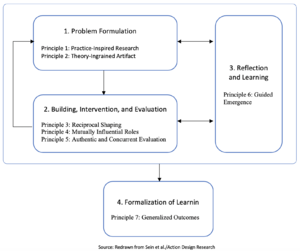Action Design Research according to Sein et al
Introduction
Process description
Action design research is a research method for generating prescriptive design knowledge through the building and evaluating ensemble IT artifacts in an organizational setting. It deals with two seemingly disparate challenges:
- addressing a problem situation encountered in a specific organizational setting by intervening and evaluating
- constructing and evaluating an IT artifact that addresses the class of problems typified by the encountered situation
The responses requested by these two challenges result in a method that focuses on constructing, intervening, and evaluating an artifact that represents not only the researchers 'theoretical precursors and purpose but also user impact and ongoing use in context.
Problem Formulation
Description
Tasks to be performed in the problem formulation activity:
- Identify and conceptualize the research opportunity
- Formulate initial research questions
- Cast the problem as an instance of a class of problems
- Identify contributing theoretical bases and prior technology advances
- Secure long-term organizational commitment
- Set up roles and responsibilities
Examples
Further Readings
Brocke, Jan vom; Simons, Alexander; Niehaves, Bjoern; Niehaves, Bjorn; Reimer, Kai; Plattfaut, Ralf; and Cleven, Anne, "RECONSTRUCTING THE GIANT: ON THE IMPORTANCE OF RIGOUR IN DOCUMENTING THE LITERATURE SEARCH PROCESS" (2009).ECIS 2009 Proceedings. 161. https://aisel.aisnet.org/ecis2009/161
Sein, Maung K.; Henfridsson, Ola; Purao, Sandeep; Rossi, Matti; and Lindgren, Rikard. 2011. "Action Design Research," MIS Quarterly, (35: 1) pp.37-56.
Webster J and Watson RT (2002) Analyzing the past to prepare for the future - Writing a literature review. Management Information Systems Quarterly 26(2), xiii-xxiii.
Building, Intervention, and Evaluation
Description
Tasks to be performed in the building, intervention, and evaluation activity:
- Discover initial knowledge-creation target
- Select or customize BIE form
- Execute BIE cycle(s)
- Assess need for additional cycles, repeat
Examples
Further Readings
Sein, Maung K.; Henfridsson, Ola; Purao, Sandeep; Rossi, Matti; and Lindgren, Rikard. 2011. "Action Design Research," MIS Quarterly, (35: 1) pp.37-56.
Reflection and Learning
Description
Tasks in the reflection and learning activity:
- Reflect on the design and redesign during the project
- Evaluate adherence to principles
- Analyze intervention results according to stated goals
Examples
Further Readings
Sein, Maung K.; Henfridsson, Ola; Purao, Sandeep; Rossi, Matti; and Lindgren, Rikard. 2011. "Action Design Research," MIS Quarterly, (35: 1) pp.37-56.
Formalization of Learning
Description
Tasks to be performed in the formulation of learning activity:
- Abstract the learning into concepts for a class of field problems
- Share outcomes and assessment with practitioners
- Articulate outcomes as design principles
- Articulate learning in light of theories selected
- Formalize results for dissemination
Examples
Further Readings
Sein, Maung K.; Henfridsson, Ola; Purao, Sandeep; Rossi, Matti; and Lindgren, Rikard. 2011. "Action Design Research," MIS Quarterly, (35: 1) pp.37-56.
